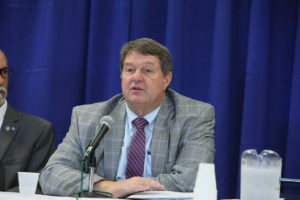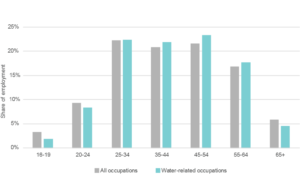Coverage of water workforce topics supported by waterTALENT
At WEFTEC 2019 in Chicago, U.S. Environmental Protection Agency (EPA) Deputy Assistant Administrator for the Office of Water Dennis Lee Forsgren Jr., announced a new effort to help American utilities surmount the looming water-sector skills shortage expected in coming years.

During WEFTEC Technical Session No. 200: Water Policy Update, U.S. Environmental Protection Agency (EPA) Deputy Assistant Administrator for the Office of Water Dennis Lee Forsgren Jr., unveiled America’s Water Workforce Initiative, which will formulate an action plan to attract and preserve talent in U.S. water utilities. Photo courtesy of Oscar & Associates
EPA plans to release a draft of America’s Water Workforce Initiative for public comment by the end of this winter, Forsgren told the audience during Technical Session No. 200: Water Policy Update. A final plan for the program is due in spring.
“America’s Water Workforce Initiative will help us take meaningful steps together to recruit, retain, and support the water workforce,” Forsgren said. “The federal government serves as an important convener on this national issue and commits to provide federal leadership, seek close collaboration with partners, and work to bolster water careers — these elements encompass the three goal areas of the plan.”
According to a 2018 report from the Brookings Institution (Washington, D.C.), Renewing the water workforce: Improving water infrastructure and creating a pipeline to opportunity, approximately one-third of U.S. drinking water and wastewater operators will be eligible for retirement by 2028. Because the water workforce tends to be slightly older than the average for other sectors, thousands of water utilities will need to work toward filling vacancies to ensure they can continue meeting the needs of their communities.

The U.S. water sector faces a looming skills shortage as approximately one-third of the current workforce is expected to reach retirement age within the next decade. Utilities will need to adopt aggressive workforce development strategies to continue protecting public health and the environment in their communities effectively. Image courtesy of the Brookings Institution and U.S. Bureau of Labor Statistics
“Building a dynamic and diverse water workforce for the 21st century is absolutely vital to continuing to deliver on our sector’s mission to protect public health and the environment,” said Tom Kunetz, 2018-2019 President of the Water Environment Federation (WEF; Alexandria, Va.). “WEF is very grateful that EPA is collaborating with our organization and others to address critical workforce needs and believes the agency’s support will help advance current initiatives and better target federal efforts to the water sector.”
Filling water-sector positions is difficult because many would-be operators, engineers, and scientists do not know about the opportunities the industry offers.
EPA and WEF each offer a number of resources to help raise awareness about the benefits of working for water. These include:
From CWEA and CA-NV AWWA:
From EPA:
From WEF:
America’s Water Workforce Initiative will work in tandem with these programs to attract more talent to U.S. water resource recovery facilities, said Forsgren.
“We see the workforce challenge as a great opportunity to collaborate with you to find effective paths forward. This is the only way something this large and this important can be addressed successfully,” Forsgren said.